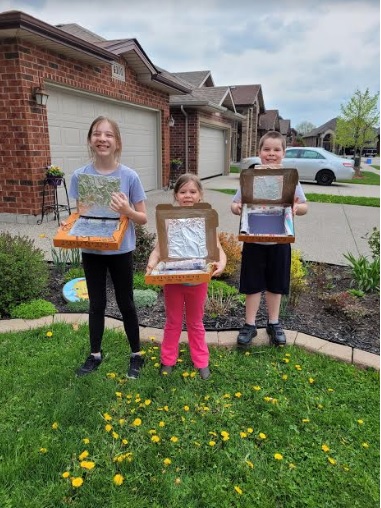
As an educator or parent (or both), you’re aware that game-based activities can be a catalyst to drive student learning. You’ve likely also seen how competition can encourage kids to strive to accomplish more than what is required. Introducing a goal or an environment that ranks one team’s performance against others, can push kids to achieve more.
The League for Green Leaders is a unique student-based competition. It teaches participants how they can influence their impact on the environment by measuring their personal carbon footprint and comparing the results to other competitors to win an eco-education challenge.
How do participants sum up the experience? Says League player Sam, a grade 3 student from Ontario, “Awesome. Amazing. The best!”
The League for Green Leaders was designed with multiple goals in mind: to stimulate learning through hands-on activities, to encourage a sense of teamwork and togetherness by framing the activities as a competition where classrooms and schools rally their student body to face off against other schools and see their progress in the leaderboard challenge, and to offer children a sense of hope as it pertains to the climate crisis our planet is facing by empowering them to affect their carbon footprint based on the day-to-day action they take.
Game-centered carbon footprint activity
Launched in 2021, the League for Green Leaders saw over a thousand participants join the challenges in its first two years. Each competition season takes place over 14 days, and seasons are held four or five times a year throughout the regular academic calendar.
The League for Green Leaders is unique as the world’s first-ever gamified online climate action competition for school-age children.
“We think that climate education should be playful, relevant, and empowering,” says Jane Ji, CEO and co-founder of Springbay Studio explaining why the League was created.
And it’s fun. Kids love the excitement the League activities offer.
“I was really excited about this competition because it’s about the environment and different ways we can help decrease our impact on it,” says Mariam Sarikaya, an eighth grader who participated in the challenge in 2022.
“I played a bunch of really educational and fun games,” says Joon, a fifth grader from Windsor, Ontario.
Tangible impact on carbon footprint

Students participating in the League activities have saved more than 1000 kg (or 1 tonne) of carbon dioxide in each competition to date. That’s equivalent to 500 carbon dioxide fire extinguishers or 500 m3 hot air balloons. Put another way, 50 trees must grow for one year to capture that amount of greenhouse gas emissions. Participants in the league contribute to that direct environmental impact in 14 days.
One such activity is “Big Talk.” The objective is for participants to examine their personal carbon footprint and communicate how we can make an impact on climate change together. After watching a video from the United Nations Climate Change Conference, participants play the “iBiome-Changing Ice”game which shows them the effects of individual actions on climate change. Then they are asked to document what actions they’d like their government to take towards reducing carbon dioxide to meet its carbon dioxide emissions reduction targets and to share what they learned with family members.
Beyond the positive environmental impact, students experience many other benefits when participating in the League for Green Leaders competition.
Teamwork is a word that is repeated often when you ask participants what they enjoyed about the League. Says Joon, “You get to do a bunch of fun activities and work with your teammates which is really fun.”
“My child liked this program because it’s a great balance of being educational while being a lot of fun as well,” says Justin, the parent of a past League participant. “She had a great time learning how to track her greenhouse gas emissions. She was always really energized.”
Extra benefits of League for Green Leaders
In addition to learning to work together, some of the soft skills they develop when participating in team-based activities include leadership, effective communication, motivation, and adaptability. Wrap the activity in a competition and you gain the additional benefits of building mental toughness with safe scenarios where students can practice these skills, enhancing beneficial peer comparisons, developing agency, and enhancing social and emotional learning, to name just a few.
The League for Green Leaders also features a leaderboard mechanism, a powerful tool that engages the learners. School teams submit the results of their aims to reduce their carbon footprint each day. The leaderboard tracks and displays the progress throughout the competition for all teams to see. So, in addition to a team’s internal goal, the leaderboard also provides an external motivation to drive the teams to increase their performance.
In creating a sense of empowerment for participants, the League also helps to address a growing concern among educators: eco-anxiety among school-aged children. This is defined as extreme worry about harm to the environment caused by human activity.
“From our case study with the Toronto District School Board, 50% of the students who experience eco-anxiety are empowered to reduce more on their carbon emissions, and feel more positive about the impact we can create together,” says Springbay’s Jane Ji.
Engaging students who struggle
The League for Green Leaders competition can also capture the imagination of students who have a hard time connecting with some material delivered in the classroom.
“I know that it was highly engaging to the students,” says Ontario grade 4 and grade 5 teacher Sharon L.. “particularly one student whose mother emailed me and told me that he was having difficulty engaging in regular classes but spent so many hours in the competition for the Green Leaders.”
What advice about the League for Green Leaders would past participants share with their friends and other school-aged kids? “I want other kids to know that it’s educational but you have fun by learning things and playing games and working with your teammates,” says Joon.
Win or lose the competition, all League participants are rewarded in the end knowing they’ve done something good for the planet.
